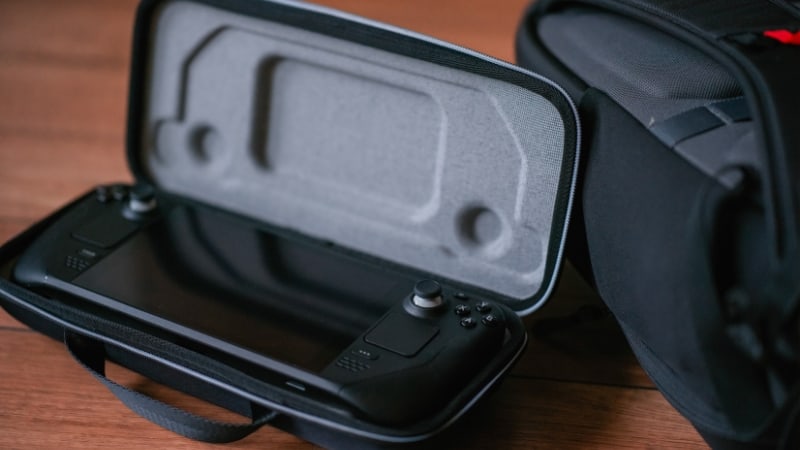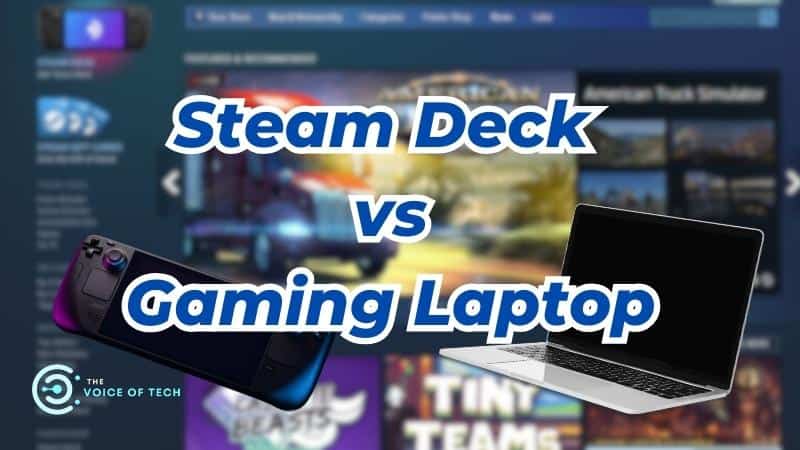
Expert Consulted: Adrian Gardiner. Years of experience buying both computers and gaming computer equipment have helped give me a unique perspective on gaming equipment. In this article, I’ll be sharing my knowledge on a Steam Deck vs Gaming Laptop comparison.
Choosing between a Steam Deck and a Gaming Laptop is no easy decision as they would both be desirable platforms to use but there are big differences to consider between them both.
Both devices offer the chance to game on the go with your favorite gaming choices but with compromises in terms of portability and the level of gaming power offered due to the differences in hardware specifications.
Ultimately, what device you decide to use will depend on your gaming needs and preferences. It should also be noted that at today’s current pricing, the Steam Deck is not exactly cheap at $399.99 for the base 64 GB model.
Steam Deck vs Gaming Laptop Compared
We’re always on the lookout for ever easier ways of having fun and being able to play our favorite games wherever we happen to be – well I am anyway!
Each platform is designed for a specific situation/need, and for the Steam Deck, this would be portability and convenience.
The Gaming Laptop, whilst still portable, is much heavier but would have much more gaming power and also would provide a much nicer experience with its larger screen.
Overview of the Steam Deck vs Gaming Laptop
The following table illustrates the main Steam Deck vs Gaming Laptop differences.
| Platform Benefits | Steam Deck | Gaming Laptop |
| Convenience & Ease of Use | Excellent | Good |
| Portability | Small and light | Excellent but depends on the spec. |
| Gaming Performance | Excellent for its size | Excellent but depends on the spec. |
| Display | 7″ | 15.6 to 17.3″ |
| Battery Life | 2 – 8 hrs | 3 – 10 hrs |
| Game Compatibility | Good | Excellent |
| Cost | From $399.00 – $649.00 | From $300.00 to $5000.00+ |
When comparing the two devices, depending on your chosen specification, the laptop could be both reasonably small (12″ screen) and lighter (using lightweight materials like magnesium alloy for example) but at a hefty price premium.
On the other hand, you may want a 17″ laptop but with a degree of portability – difficult to achieve with such a large and bulky device.
A device that can provide a PC-level gaming experience, for a reasonable price but be really portable sounds like the perfect combination and this is where the Steam Deck comes in.
There are 4 key points that should be considered when looking at the Steam Deck and a Gaming Laptop:
- Performance
- Portability
- Game Compatibility
- Price and Value for Money.
I’ve covered each of these points in the following sections.
1: Performance Comparison
The Steam Deck and Gaming Laptop are both powerful devices each in their own right but with consideration as to how they will be used and the limitations of each form factor.
For hand-held, portable gaming the Steam Deck is excellent and will play most of the latest AAA games. However, if you want more power and a better screen, a Gaming Laptop is excellent.
Gaming Performance
Steam Deck
The Steam Deck was designed purely for gaming and comes with a custom-designed AMD APU (accelerated processing unit) that includes a quad-core Zen 2 CPU and RDNA 2 GPU to enable you to play the latest AAA games.
Computing Specification:
| Processor – AMD APU with Zen 2 CPU and RDNA 2 APU. 2.4 to 3.5 GHz (CPU) |
| RAM – 16 GB LPDDR5 (5500 MT/s) |
| Storage – 3 options including, 64 GB eMMC (PCIe Gen 2 x1), 256 GB NVMe SSD (PCIe Gen 3 x4 or PCIe Gen 3 x2), and 512 GB NVMe SSD (PCIe Gen x4 or PCIe Gen 3 x2)* |
Gaming Laptop
A Gaming Laptop can be purchased with a wide array of hardware options with considerably more powerful CPUs and GPUs to deliver much higher frame rates and better graphics performance than a Steam Deck.
However, depending on the quality of the laptop purchased, some gaming laptops can experience limiting thermal throttling issues during long and demanding gaming sessions.
There are more expensive and better-designed gaming laptops available with enhanced cooling that are designed to reduce and/or eliminate the possibility of thermal throttling.
Computing Specification:
| Processor – AMD Ryzen 3 to 9 or Intel i3 to i9 |
| RAM – 8 to 64 GB DDR 4 / 5 |
| Storage – 512 to 4 TB+ NVMe, PCIe 4 / 5 SSD |
| GPU – NVIDIA GTX 1660 or RTX 2060 to 4090 or AMD Radeon Graphics, AMD Radeon 610M, 660M, 680M, 740M, 760M, 780M |
Usability and Versatility
Again, both the Steam Deck and Gaming Laptop offer great usability and versatility but with different gaming environments in mind.
Steam Deck
The Steam Deck’s handheld form factor means it’s very easy to carry and game pretty much anywhere – no need for a separate display or screen as these are both built-in.
With a touchscreen built into the 1280 x 800 px, 16:10 aspect ratio, IPS display you don’t need a keyboard and 6-Axis gyroscopic controls make for a really immersive gaming experience (like gaming on your mobile, where you move the phone to move around in a game).
Gaming Laptop
In comparison, a Gaming Laptop comes with a lot more flexibility and many more customization options, in addition to being able to run non-gaming programs and support a variety of peripheral devices (like an even bigger screen, game controllers, joysticks, etc.).
Even the smallest laptop display (starting at around 14″ for a gaming device) is going to be much bigger than the Steam Deck.
The larger built-in keyboard will offer a more friendly, ergonomic, and comfortable gaming experience for longer sessions and productivity-based work.
Power Usage
We need to look at power usage too as both will differ greatly, due to their differences in hardware.
Steam Deck
The Steam Deck can run for 2 to 8 hours with its 40Whr battery, depending on the game(s) you play and general usage and device settings. Charging is taken care of with a 45w USB C cable.
Although having been designed from the ground up for portable gaming the Steam Desk is quite power-efficient but can be prone to getting quite hot with extended use in hot environments (Steam recommends gaming in ambient temperatures from 0 – 35 degrees C).
When the device gets too hot it’s designed to throttle performance to protect itself and if necessary shut down.
If your device becomes hot to the touch or becomes noisy during operation, the recommendation would be to shut it down and allow it to cool properly before using it again.
Gaming Laptop
Although the power draw from a dedicated gaming laptop is going to be considerably higher than the Steam Deck, the actual expected battery life is going to be roughly in the same ballpark as the Steam Deck.
This battery life depends of course on the laptop hardware specification, games being played, and applications being run.
As an example, the ultra-high specification (and very expensive) Razer Blade 15 Gaming Laptop states a battery life of 7 hours – however, expect to see this figure drop quite a bit during a heavy gaming session!
Charging your gaming laptop is also not going to be as convenient as you’ll need to connect its charger to a regular wall outlet.
2: Portability / Form Factor Comparison

Gaming on the go demands portability and ease of use and both the Steam Deck and Gaming Laptop cater to this with different approaches, each according to their unique form factors.
Steam Deck
The Steam Deck format is designed for handheld gaming and is ideal for portability. With a 7″ 1280 x 800 px touchscreen display and built-in intuitive controls, it’s easy to game on the move without a separate controller.
With its built-in dock, it can also be used in desktop mode, making it truly versatile for both portable and fixed-location home gaming. Via the Docking Station (an optional item), Desktop mode allows your Steam Deck to be hooked up to your living room TV, or an external monitor or left on charge.
Gaming Laptops
In contrast to the Steam Deck, Gaming Laptops come in a wide range of different form factors, from slim and lightweight devices to much larger and more powerful gaming laptops.
Gaming laptops are never going to be as portable as a Steam Deck due mainly to their increase in screen size. However, they do offer much more versatility for gaming and productivity too. You can even get laptops with huge foldable screens and detachable or separate keyboards for additional flexibility.
What’s right for you will come down to your personal needs and preferences. For portability and handheld gaming, the Steam Deck is pretty hard to beat. But if you want better visuals and more power, a gaming laptop is definitely the way to go.
3: Game Compatibility Comparison

There are some critical differences between each of these two platforms when it comes to software and game compatibility. Let’s dive into the details.
SteamOS and their Game Library
The Steam Deck runs on its own Linux-based operating system called SteamOS and was designed specifically for gaming.
The Steam library has enormous choice but doesn’t include all available titles, some of which are only available to PC users.
Also, while the Steam Deck can play all game titles from the Steam library it won’t be able to play all of them as optimally as one would like – Steam has a list detailing all games that have been optimized and verified for use on the Steam Deck.
Can the Steam Deck play PC Games?
With the use of a special compatibility layer called Proton, the Steam Deck is able to play games on the Linux-based SteamOS, giving access to a vast selection of computer games.
How well the Steam Deck would be able to play these games is another matter entirely as any games not originally designed for the Steam Deck may struggle or not even play at all.
The Steam community has prepared a database of games that work ok with Proton, helping with your search for compatible PC-based games. Also, the Epic Games Store has added support for Proton, providing even more gaming choices.
The Windows OS
If you’re planning to game with a Gaming Laptop, you’ll have a huge choice of games available that are also compatible with ever-popular gaming platforms like Steam, Epic Games, and more.
Of course, a Gaming Laptop is a lot more versatile than the Steam Deck, with the ability to run non-gaming software programs.
You’ll need to have a laptop with the right hardware specification (i.e., fast CPU, plenty of RAM, good GPU, etc.) to play your games, with some titles requiring faster and more capable hardware than others.
Most laptops designed specifically for gaming should have no problems running the latest and most demanding games.
4: Price and Value for Money Comparison
Comparing the price and value of the Steam Deck and Gaming Laptop is not easy as they are each very different and designed for specific use cases.
For a starting price of $399.00 for the 64 GB option, $529.00 for 256 GB, and $649.00 for 512 GB, the Steam Deck is attractively priced for a good quality portable gaming solution if that’s all you need.
However, if you need a bigger screen, more power, and the ability to carry out other tasks as well as gaming, a gaming laptop is the way to go albeit for a higher price.
So long as the selected laptop was not too different in price from the Steam Deck, it might be the better long-term option, offering pretty much everything the Steam Deck can do and more.
Final Words
From the comparison outlined above it’s clear that the Steam Deck and Gaming Laptop, whilst both being portable (to differing degrees), are both designed for different situations.
The Steam Deck is perfect for the ultimate in portable gaming on the move with excellent hardware and the compatibility to play most games. The only limitation is the size of its screen and built-in storage capacity (especially taking into account the huge size of today’s computer games).
On the flipside, gaming laptops offer the potential for a huge increase in gaming power with many different specification options to choose from plus the ability to be used for many other applications as well as gaming.
A much bigger screen and the ability to handle games at much higher settings make it an attractive proposition.
Although I wouldn’t exactly call the Steam Deck cheap, it will be a lot more affordable than a dedicated gaming laptop which if taken seriously could cost anything from $1000.00 to over $5000.00!
Some people ‘really’ like their gaming equipment!
The final choice will ultimately depend on your needs and preferences.
If you need portability and a more affordable option the Steam Deck would be the way forward.
If you need more power and versatility, a gaming laptop will give you that and more.
Image Attribution and Licensing
#1: ‘A Close-Up Shot of a Steam Deck’ by Egor Komarov (Canva Pro)

